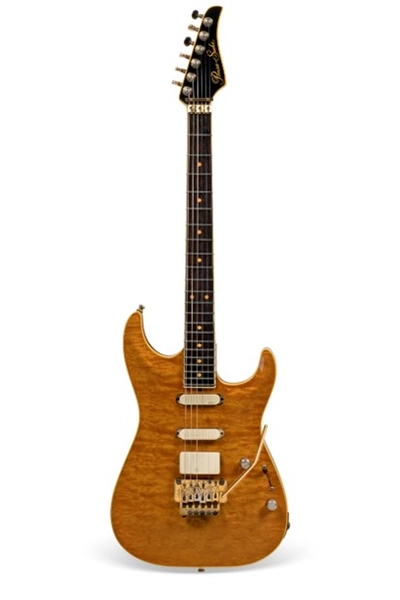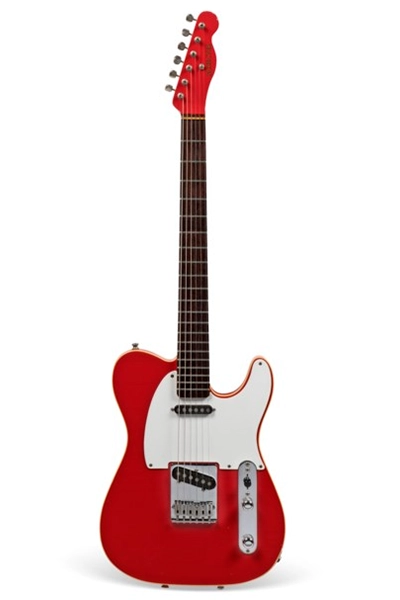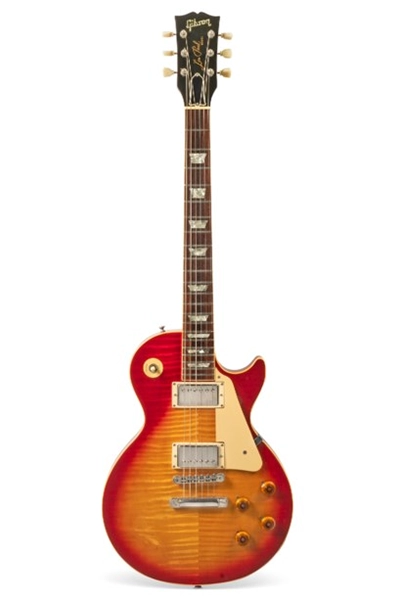13 February 2024
Sharing the joy: Mark Knopfler Collection auctioneer hammers home £8.8m
6 minutes
As the final lot at the Mark Knopfler Collection auction went under the hammer, the Christie’s team allowed themselves a full rush of adrenaline. Auctioneer Eugenio Donadoni, the team on the phones and those taking web bids donned red headbands in homage to the former Dire Straits guitarist, singer and songwriter Mark Knopfler who was sharing more than a quarter of the £8,840,160 total hammer price with charities close to his heart.
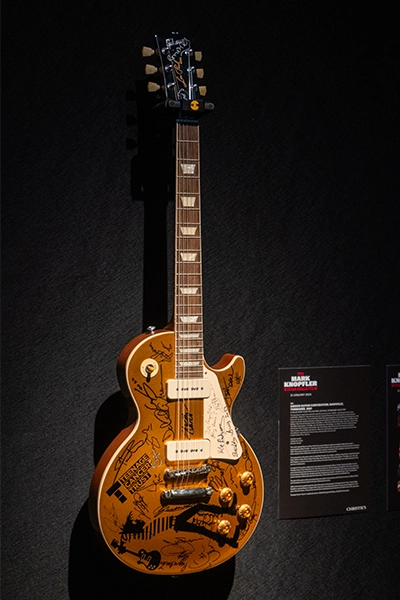 |
Excitement around the room climaxed with the last of the 113 guitar lots – a Gibson Les Paul Standard ‘Gold Top’ solid-body electric guitar signed by 33 of the finest guitarists and best-loved rock musicians on the planet including David Gilmour, Ringo Starr, Joan Armatrading, The Edge, Eric Clapton, Brian May, Sting, Roger Daltrey, Nile Rogers, Pete Townshend and Duane Eddy. With an estimate of £20,000-£40,000, bids for the guitar came in thick and fast, rising almost immediately to six figures. Auctioneer Eugenio Donadoni, clearly enjoying the lively finale, joyfully urged and accepted bids from across the world before selling the instrument for £403,200. It was a satisfying end to the white label auction (everything was sold) with 100 percent of the money for that guitar donated to the Teenage Cancer Trust as well as at least 25 percent of the auction total going to the British Red Cross Society, Brave Hearts of the North East, and the Tusk Trust. Christie’s, too, contributed a further £50,000 to each of the charities. (Image: Gibson Les Paul Standard ‘Gold Top’ solid-body electric guitar signed. Sold for £403,200.) |
Stealing the show
Knopfler’s 1959 vintage Gibson Les Paul Standard, used on his Sailing to Philadelphia tour in 2001 and Kill to get Crimson tour in 2008, was the auction’s showstopper, starting with an estimate of £300,000-£500,000. This true collector’s instrument, with a beautifully faded cherry-red sunburst finish, sold for £693,000. It was a holy grail acquisition, even for a seasoned guitar hero like Knopfler, who said in the Christie’s catalogue “Gibson is one of the most beautiful words in the English language. This is guitar is a killer... A guitar like this will spoil you.”
Amelia Walker, Christie’s Head of Sale Specialist and Head of Private & Iconic Collections, said: “As well as the provenance, this guitar is special because you have a huge amount of tonal variation in the timber. The maple on the top is beautifully quilted, but it's also got a shimmer. The sunburst, which goes out to the red at the edge, has not discoloured too much so this is a highly prized instrument and it also has an original case.”
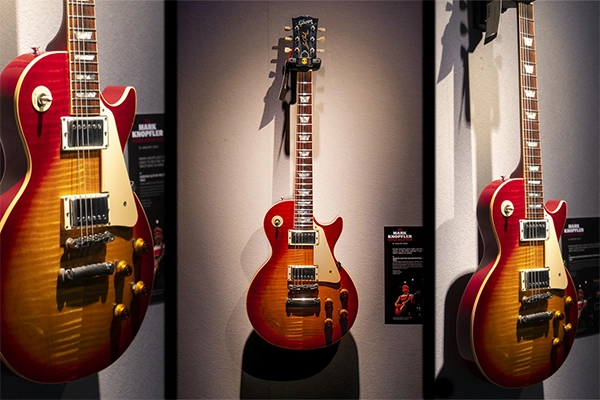 |
(Image: 1959 vintage Gibson Les Paul Standard. Sold for £693,000)
Further world auction records were set by the 1988 Pensa-Suhr MK-1, co-designed by Knopfler to play at the Nelson Mandela 70th Birthday Tribute concert in 1988 at Wembley Stadium, selling for £504,000, and the red Schecter Telecaster used to record the Dire Straits’ hit ‘Walk of Life’, fetching £415,800. The 1983 Gibson Les Paul Standard ’59 Historic Reissue, used by Knopfler to record and perform ‘Money for Nothing’ and ‘Brothers in Arms’ and played on stage at Live Aid, achieved £592,200.
|
(Image: 1988 Pensa-Suhr MK-1. Sold for £504,000) |
(Image: Red Schecter Telecaster. Sold for £415,880) |
(Image: The 1983 Gibson Les Paul Standard ’59 Historic Reissue. Sold for £592,200) |
In their hey-day, 1978 to 1992, Dire Straits recorded some of the most iconic music of their era; Brothers in Arms (1985) sold more than 30 million copies worldwide and remains the UK’s eighth best-selling album. It also became the first CD to sell more than a million copies, while Money for Nothing reached No. 1 in the UK and was the first music video to be played on MTV Europe.
Many guitars (and amplifiers) in the collection had been the ‘tools’ for some of the best albums and tours of all time and Knopfler conceded: “I’ll be sad to see them go, but we’ve had wonderful times together and I can’t play them all.”
Amelia Walker told me during a private tour of the collection: “Mark has songs going round in his head all the time and is always looking for a new sound, always looking for a new tone. What makes him such a unique player is he uses his fingers, not a pick, so he gets a completely different sound. He plays right-handed, although he's left-handed, so he has a strong left hand and can bend the strings in a way that probably most people wouldn't be able to.
“When I've heard him speak about not having a guitar lesson, it was probably to his advantage because he had to figure it out himself. He also had a range of influences – listening to skiffle in the 1950s and then rock ‘n’ roll, rockabilly, country and blues. Celtic music was also a big influence. It's probably how he developed his own unique style. When you listen to a Dire Straits track, you can tell it's him playing because he has a distinct sound.
“He talks about guitars like they're friends. He sees personality in every one. He also talks about the fact that he's a bit addicted to buying guitars. By his own admission, he's now only really playing about two dozen regularly but he’s still recording music.”
Knopfler’s new album One Deep River will be released on April 12 (markknopfler.com).
How it all began
Knopfler, 74, who was born in Glasgow and moved as a child to Blyth in Northumberland, would gaze at a red Fender Strat guitar in a music shop window on his way to and from school. Knopfler told Christie’s that he “wanted a guitar so badly that he used to smell the Fender guitar catalogue”.
Amelia added: “Mark said that he always wanted to be in a band and used to draw pictures of bands when he was in school. He said ‘I used to draw pictures of guitars all day. I used to go and watch a guy in the woodwork room making a guitar, just so I could hold it.’
“The guitar-obsessed boy eventually persuaded his dad to buy him a red twin pick up Hofner V2 which cost £50, the equivalent of at least £1,000 in today’s money. It had to be red, like his hero Hank Marvin of The Shadows.
“There was no more cash for an amplifier, so Mark plugged it into the family radio until the speaker blew up! He therefore got into finger-picking as he had no amp.”
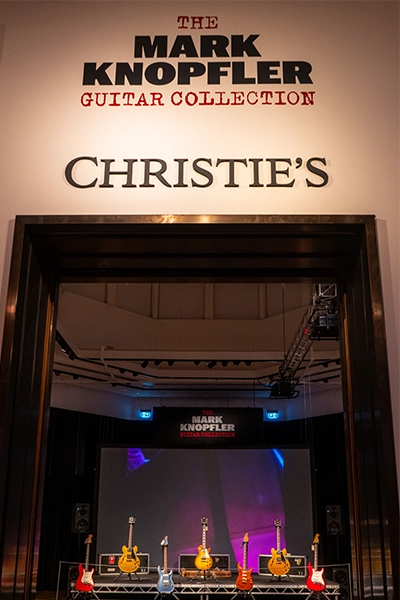 |
The museum-quality exhibition of guitars at Christie’s featured several rooms, including a large space with a stage and a giant screen showing clips from Dire Straits’ performances from around the world as well as an immersive sound experience Dolby Atmos Room, where visitors could listen to Dire Straits tracks. The collection attracted thousands of fans from across the world, generating excitement for almost two weeks before the auction, with more than 2,300 registrants from 61 countries taking part — 84 percent new to Christie’s — in an auction that lasted over six hours. This immersive tour for Dire Straits and guitar fans, who, even if they were not successful in their bids, were able to dive into the music and view the 113 guitars plus several amplifiers and cases. Congratulations to Mark Knopfler for making a big decision to part with so many of his treasured guitars – so, as he says, “they can be played by people who can find new songs in them” – and to Christie’s for putting on a memorable, prestige sale. Christie’s next music-themed auction, The Elton John Collection ‘Goodbye Peachtree Road, runs from February 9-21, 2024 in New York and features art, fashion and objects from the singer’s Atlanta home on Peachtree Road, including a custom Damien Hirst to an extravagant 18th-century costume designed by Sandy Powell. Visit christies.com |
Insuring your collection
Whether you’re a collector of guitars, antique clocks or whiskey, you will need to keep up-to-date with its value and insure it correctly, as in the event of a claim you don’t want to realise you’re underinsured.
The things you collect require specialist insurance. A standard home insurance contents policy is unlikely to be suitable as it will contain sub-limits and exclusions. Typically, within a home contents policy, there will be a financial limit on jewellery, watches and art. Similarly, a musical instrument may well be excluded under a home policy if it’s worth more than a certain value, is taken out of the home, or used professionally.
Insuring your collection properly may also give other benefits including depreciation in value following damage, pairs and sets cover, particularly relevant to drum kits and even a death of artist extension.
If you would like to discuss your collection, whatever its contents, call our team of specialists on 020 8256 4901, or email privateclients@howdeninsurance.co.uk

